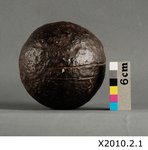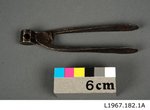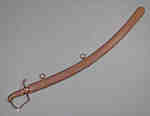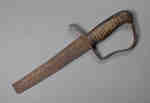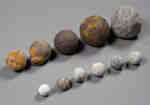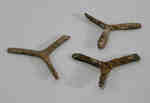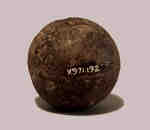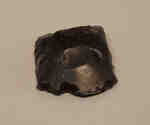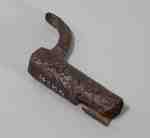Résultats
- This type of cannon ball was used during the War of 1812. This round, black ball of iron has a pitted surface and is 14 1/2 inches in circumference and 5 inches in diameter. There is a 4 mm wide andThis type of cannon ball was used during the War of 1812. …
- A musketball mould of the type made and used pre-1830. An iron, plier-like tool with two handles. At the end of each handle is a mini-pan with semi-spherical moulds inside. When the two handles are bA musketball mould of the type made and used pre-1830. An iron, …
- The blade is 80.5 cm long x 2.5 cm wide and tapers to a spear point. The pattern is common to that of 1769 but was most likely still used by the War of 1812. The sword has an urn hilted pommel with aThe blade is 80.5 cm long x 2.5 cm wide and tapers …
- The sabre and scabbard are curved steel that has since rusted. The scabbard has two steel bands with two rings attached and a rounded tip. It has “OSBORNE & GUNBY, BIRM.” inscribed on the base. The sThe sabre and scabbard are curved steel that has since rusted. The …
- Set of cannon balls that were unearthed in one of Niagara's battlefield sites.Set of cannon balls that were unearthed in one of Niagara's battlefield …
- This cavalry sword with a wooden handle is measured at 13 ¾ inches long. It was said to have been recovered from one of Niagara’s Battlefields. This item is on display at the Battleground Hotel MuseuThis cavalry sword with a wooden handle is measured at 13 ¾ …
- These are various sizes of small cannon shot and musket balls from the Battleground Hotel Museum.These are various sizes of small cannon shot and musket balls from …
- This iron tool was used to strike a flint to create sparks and start a fire. The arms of the tool curve inward, towards the center of the tool. The flint striker is fairly rusted.This iron tool was used to strike a flint to create sparks …
- These prickers, dated 1812, were used as a screwdriver for a musket. It is “Y” shaped, with the top “V” forming the handle and the bottom arm narrowing to fit into the screw. The musket tool was usedThese prickers, dated 1812, were used as a screwdriver for a musket. …
- The sword, which is made of brass and steel, has a lion's head pommel and a curved blade. Along with its scabbard, it is believed to have belonged to the Musician in Captain Raunchey's Volunteers (CoThe sword, which is made of brass and steel, has a lion's …
- This is a wooden ramrod, circa 1812-1814, that was used by the artillery to wedge the ball into the breech of the cannon. 196 cm long and painted black.This is a wooden ramrod, circa 1812-1814, that was used by the …
- This triangular bladed bayonet was designed to fit on the muzzle of a rifle or musket barrel, making it into a close range weapon. This would have been on arguably every soldier’s firearm during theThis triangular bladed bayonet was designed to fit on the muzzle of …
- This musket, circa 1812, is a 3rd Model “Brown Bess” 1790 with an “India Pattern” design. It was a British regulation issue flintlock musket. There are various engravings on the musket that include:This musket, circa 1812, is a 3rd Model “Brown Bess” 1790 with …
- This iron fashioned ammunition was likely created during the War of 1812 period. It gives an insight into the appearance of military munitions during the 1812 time. Diameter: 5 cmThis iron fashioned ammunition was likely created during the War of 1812 …
- An English prismatic type of flintlock that measures 3.7cm x 2.5cm. It belongs to the Servos Collection and was found at Niagara.An English prismatic type of flintlock that measures 3.7cm x 2.5cm. It …
- This is a steel spear point from a Sergeant’s spontoon in the British Army infantry from 1800 to 1820. A spontoon signified a sergeant’s rank.This is a steel spear point from a Sergeant’s spontoon in the …
- This is a bayonet socket with a small portion of the blade attached that was discovered in the Niagara River. A bayonet is a steel blade that is designed to fit on the muzzle of a rifle or musket barThis is a bayonet socket with a small portion of the blade …
- This bayonet, dated 1812-1814, has triangular blade. It was recovered from the Niagara River in 1980.This bayonet, dated 1812-1814, has triangular blade. It was recovered from the …
- This is a lock mechanism measuring 17.7 cm x 3.1 cm, that was made for a tower musket. This lock mechanism was converted to percussion. There are four perforations and markings include “Tower”, a triThis is a lock mechanism measuring 17.7 cm x 3.1 cm, that …
- This is an iron lock mechanism measuring 13.9 cm x 2.5 cm x 3.1cm that is a flintlock from a military pistol. There are seven perforations and markings include “1812”, “2”, and a rampant lion presentThis is an iron lock mechanism measuring 13.9 cm x 2.5 cm …





